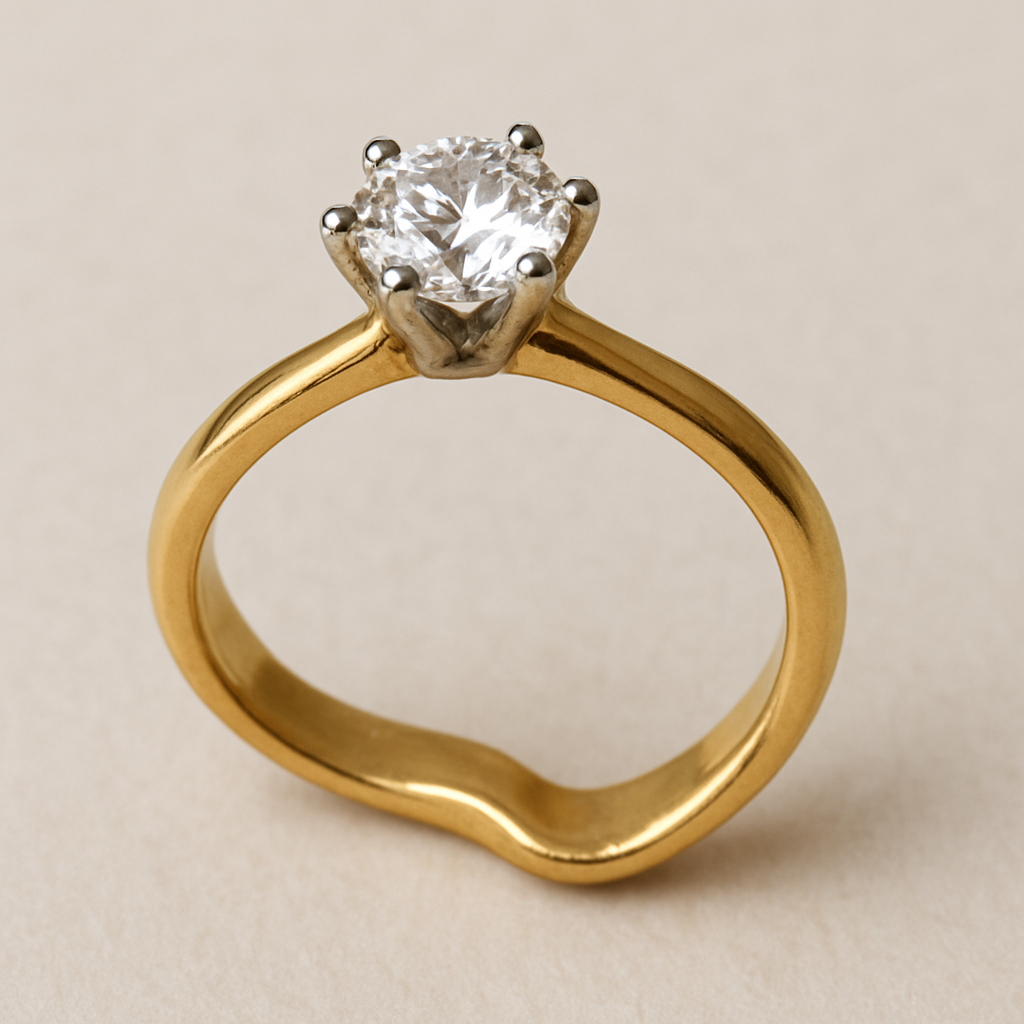
Why Your Ring Is Bending and How to Stop It Now
Why Is the Bottom of My Ring Bent? Causes, Metal Types, Prong Issues, and How to Fix It
Rings are a timeless expression of style, love, and commitment. Whether it’s a wedding band, a family heirloom, or your favorite fashion statement, a bent ring can be a cause for concern. If you’ve noticed that the bottom of your ring—known as the shank—is bent, or that the prongs holding your gemstone are loose, you’re not alone. Many ring wearers experience this, especially when the ring is made from malleable metals like gold, silver, or even platinum.
In this blog, we’ll explore:
- Why the bottom of your ring may bend
- How metal types like gold, silver, and platinum impact durability
- Why prongs can bend and what risks they pose
- What you can do to fix a bent ring or prongs
- How to prevent ring bending and prong damage in the future
Let’s dive in.
What Is the Shank of a Ring?
Before we get into the reasons for ring damage, it's important to understand the terminology. The shank refers to the band or circular portion of a ring that wraps around your finger. The bottom of the shank is the section that sits beneath your finger—the area most exposed to daily wear and tear.
Why Do Rings Bend at the Bottom?
A bent shank is typically the result of one or more of the following:
1. Soft or Malleable Metal
Some metals are naturally softer and more pliable than others. Over time, pressure from gripping, lifting, or hitting your hand against hard surfaces can cause these metals to bend.
2. Thin or Delicate Band Design
Rings with ultra-thin bands or minimalist designs are more prone to bending. While elegant and dainty styles are popular, they may lack the structural strength to withstand daily pressure.
3. Improper Ring Size
If your ring is too tight, the pressure against your finger can deform the shank over time. Conversely, if it's too loose, it may shift and take more damage from everyday use.
4. Heavy Ring Tops
Rings with large stones or heavy settings can be top-heavy, causing added stress on the bottom of the band.
5. Daily Wear and Tear
Activities like typing, working out, carrying bags, or using tools can all contribute to ring bending—especially if you rarely take your ring off.
How Malleable Metals Affect Ring Durability
Let’s explore how common ring metals—gold, silver, and platinum—respond to pressure and impact over time.
Gold: Beautiful but Soft
Gold, especially in higher karats (like 18K or 22K), is a soft and malleable metal. While it’s known for its luxurious luster and timeless appeal, its softness makes it more susceptible to bending.
- 18K Gold contains 75% pure gold. It’s softer and more likely to bend than 14K gold.
- 14K Gold (58.3% pure gold) is mixed with stronger alloys and is more durable for daily wear.
- 10K Gold is even harder but may appear slightly less rich in color.
Bottom line: The higher the gold content, the softer and more likely it is to bend.
Silver: Soft and Affordable
Sterling silver, typically made of 92.5% pure silver and 7.5% copper, is also a soft metal. While affordable and highly reflective, silver is more prone to bending and scratching than gold or platinum.
Because silver is one of the softer precious metals, it's common for silver rings to bend with regular wear—especially at the bottom of the shank.
Platinum: Durable but Not Indestructible
Platinum is denser and heavier than both gold and silver, making it more durable for everyday wear. It’s less likely to bend under normal conditions, but it’s not completely immune.
Unlike gold, which wears away when scratched, platinum tends to displace rather than lose metal. So while it may not thin out as quickly, it can still bend under strong force or impact.
Can a Bent Ring Be Fixed?
Yes! A bent ring is almost always repairable, especially if caught early. A professional jeweler can evaluate the severity and fix the damage using specialized tools and techniques.
How Jewelers Fix Bent Rings:
1. Ring Reshaping
If the bend is minor, the jeweler can use a ring mandrel and mallet to gently round out the shape without damaging the stone or setting.
2. Reinforcement or Resizing
If the ring is too thin or weak, the jeweler may suggest adding extra metal to the shank or resizing it for a better fit.
3. Re-shanking
For severely damaged rings, a full or partial shank replacement might be necessary. This involves cutting out the bent section and soldering in a new, stronger piece of metal.
4. Polishing and Refinishing
After repairs, the jeweler will often polish the ring to restore its original finish, making it look brand new.
Can You Fix a Bent Ring at Home?
It’s not recommended. While it may be tempting to try bending your ring back into shape using pliers or a hard surface, you risk causing cracks, metal fatigue, or damaging the setting.
DIY fixes can turn a minor repair into a costly mistake—especially for rings with gemstones or intricate designs.
How to Prevent Your Ring from Bending Again
Prevention is the best protection for your fine jewelry. Here are a few tips to help:
1. Choose the Right Metal
If you're buying a ring for everyday wear (like an engagement ring or wedding band), opt for stronger alloys. For gold, 14K is usually a great balance of durability and beauty.
2. Avoid Wearing During Activities
Take your ring off when:
- Working out
- Lifting heavy objects
- Cleaning
- Gardening
- Doing any manual labor
3. Proper Ring Sizing
Make sure your ring fits snugly but comfortably. A well-fitted ring is less likely to twist or bend during use.
4. Routine Maintenance
Have your ring checked by a jeweler once a year. Routine maintenance can catch early signs of wear, thinning, or bending before they become serious.
5. Reinforce Thin Bands
If you love the look of a dainty ring, consider reinforcing the bottom of the shank with a thicker band or a structural support. Jewelers can custom-modify designs without compromising the overall look.
What About Bent Prongs? Your Stone Could Be at Risk
While a bent shank is concerning, bent or damaged prongs pose an even more serious threat—your gemstone could fall out. Prongs are the tiny metal claws that hold a stone securely in place. They’re most commonly found on engagement rings, cocktail rings, and other jewelry with mounted gemstones.
When one or more prongs become bent, worn, or broken, the stone can become loose and may even fall out entirely. Unfortunately, many people don’t notice bent prongs until it’s too late.
Why Do Prongs Bend?
Prongs may seem small, but they perform an essential function. Because they stick out from the band and are raised above the rest of the ring, they’re the most vulnerable part of the setting.
Here are some of the most common reasons prongs bend or weaken:
1. Everyday Wear and Tear
Simple, daily activities—grabbing bags, bumping into furniture, reaching into drawers—can slowly cause prongs to shift. Over time, even slight impacts can bend or loosen them.
2. Soft Metals
Just like the ring’s shank, prongs made from softer metals like 18K gold or silver are more prone to bending. Platinum prongs are stronger but not immune to wear.
3. Thin or Delicate Prongs
Prongs are often designed to be as subtle and minimal as possible, especially in dainty or vintage-style rings. But thinner prongs are more susceptible to movement from minor impacts.
4. Snagging on Fabric
Have you ever noticed your ring catching on sweaters, towels, or bedding? This is often a sign that a prong is raised or misaligned. Repeated snagging can further pull the prong away from the stone.
5. Poorly Made Settings
Not all jewelry is created equal. Lower-quality craftsmanship can result in uneven, poorly soldered, or improperly tensioned prongs that loosen faster.
The Risks of Ignoring Bent Prongs
Bent prongs don’t just change the look of your ring—they put your gemstone at serious risk. Here's what could happen if you ignore the issue:
- Stone becomes loose: If a prong is bent outward, your gem may start to shift or rattle within the setting.
- Stone falls out: The longer a loose prong goes unfixed, the greater the chance the stone will fall out completely—and get lost.
- Damage to the stone: A loose stone is more vulnerable to chips and cracks from movement or impact.
Considering the value of gemstones like diamonds, sapphires, or emeralds, a bent prong could cost you thousands in loss or repair if not addressed promptly.
How to Tell If a Prong Is Bent or Damaged
Here are a few signs to watch for:
- Your ring snags on fabric more than usual
- You can feel the stone wiggle or shift
- You notice a gap between the stone and a prong
- A prong looks higher, lower, or misaligned compared to the others
If you notice any of these issues, stop wearing the ring immediately and take it to a jeweler for inspection.
Fixing Bent or Damaged Prongs
Prong repair is a common and straightforward service for professional jewelers. Depending on the severity, your jeweler may recommend one of the following:
1. Prong Retipping
If the prong is slightly worn or bent, it can be retipped—reshaped and reinforced with additional metal. This helps hold the stone securely and prevents future damage.
2. Prong Rebuilding
For more extensive wear, the jeweler may completely rebuild the prong or multiple prongs. This involves removing the damaged prongs and soldering new ones in their place.
3. Tightening the Stone
Even if prongs aren’t severely bent, a jeweler can tighten the setting to ensure the stone is held securely.
4. Full Setting Replacement
If the setting is heavily damaged or compromised, it may be safer (and sometimes more affordable) to replace the entire setting rather than repair each prong individually.
Preventing Prong Damage in the Future
Like ring bands, prongs need regular care and maintenance to avoid issues. Here's how to keep them in top shape:
- Inspect your prongs regularly—ideally once a month. Use a magnifying glass to check for bends, gaps, or wear.
- Have your ring professionally cleaned and inspected at least once a year.
- Remove your ring during heavy use (working out, gardening, cleaning, etc.).
- Avoid snag-prone activities while wearing prong-set rings.
Final Word: Don’t Let a Small Bend Cost You a Big Loss
Whether it’s a bent shank or a lifted prong, seemingly small structural issues can lead to serious consequences—especially when gemstones are involved. Knowing the risks, causes, and solutions for both types of damage helps you make informed decisions about caring for your fine jewelry.
At AYW Luxury, we know the value—both sentimental and financial—that your jewelry holds. That’s why we’re passionate about education, quality service, and providing access to the best repair specialists in the industry.
If your ring is bent or your stone is loose, don’t wait. Take action now to protect your investment and preserve its beauty for years to come.
